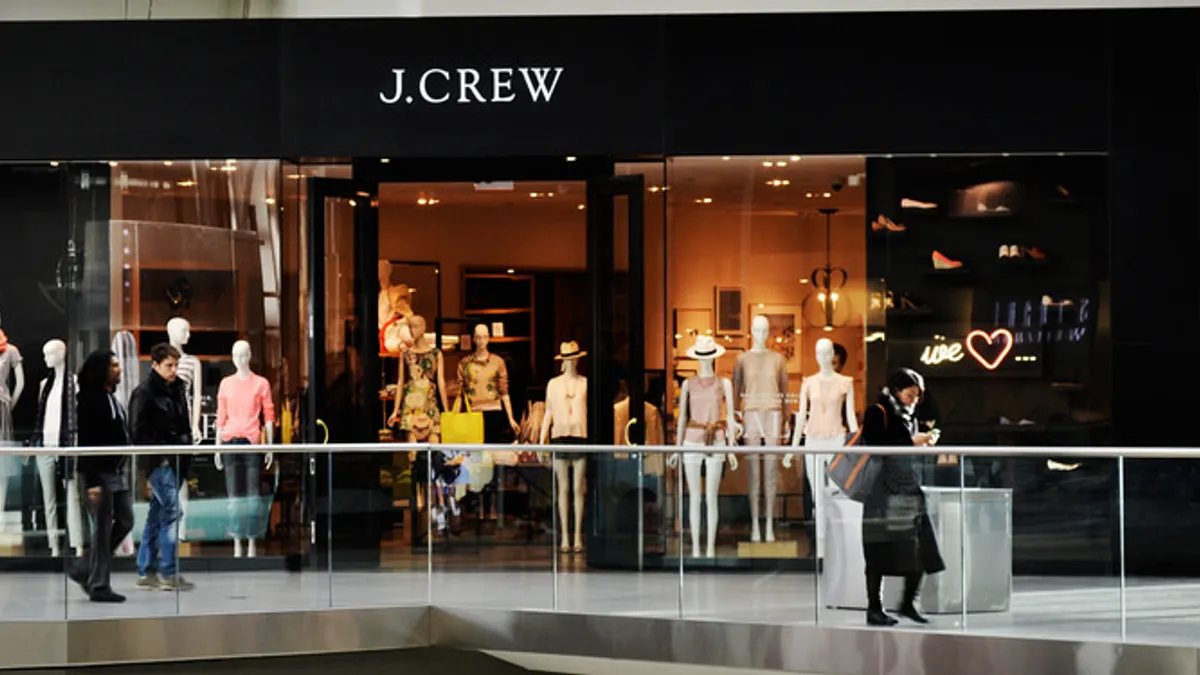Dive Brief:
-
J. Crew on Monday announced revenues fell 6% to $532 million in the first quarter as same-store sales plunged 9%, worse than its 7% decline in the same period a year ago. Operating loss in the quarter was $153.3 million compared with operating income of $7.3 million in the first quarter last year, according to a company press release.
-
By brand in the quarter: J. Crew sales fell 11% to $428.5 million, while J.Crew same-store sales fell 12%, following a decrease of 8% in the first quarter last year. Madewell sales rose 17% to $84.7 million, as Madewell same-store sales rose 10%, following an increase of 6% in the first quarter last year.
-
The company also announced plans to restructure its debt through a debt swap to exchange any and all of the outstanding $566.5 million aggregate principal amount of 7.75%/8.50% senior pay-in-kind notes due in 2019 for an equity stake and bonds that mature in 2021. At least 95% percent of bondholders must agree to that, according to a press release. The company has asked its term-loan lenders to dismiss, with prejudice, litigation relating to the assignment of its intellectual property rights, which J. Crew late last year attempted to shield by transferring them to an unrestricted Cayman Islands subsidiary.
Dive Insight:
The best news that J. Crew has had in a while came on Monday afternoon, with a report that its shirt for kids emblazoned with “The Expert” had sold out at $29.50 apiece after Barron Trump was photographed wearing one as he arrived at the White House for the summer.
Other than that, though, the company is in a “parlous state,” GlobalData Retail Managing Director Neil Saunders, told Retail Dive in an email. Saunders compared recent executive changes at J. Crew — including the planned departure of creative director Jenna Lyons and the bombshell announcement last week that CEO Mickey Drexler will step down next month — to rearranging deck chairs on the Titanic.
“There is always an argument for change, but change by itself is neither a strategy nor a solution — it needs to be accompanied by a blueprint for reinventing the business,” Saunders said. “While J. Crew has some rudimentary plans for change, we do not believe these are advanced enough to show on the shop-floor or to create a step change in business performance.”
Drexler expressed optimism in his statement on Tuesday, despite what he called disappointment with its first quarter results. "We have a clear vision and action plan in place to meet our customers' needs — wherever and however they choose to shop,” he said. “I look forward to transitioning my role to chairman and to working with our new CEO, Jim Brett, as he takes the reins in July and continues to position J.Crew for long term success."
The effects of changes presumably coming from Lyons replacement Somsack Sikhounmuong and Drexler replacement Brett, however, “may stimulate fresh thinking,” Saunders said, but in the short-term, could “more likely to prove disruptive than helpful.”
Some of the stickiest ongoing problems stem from pricing and quality issues at the flagship brand, where shoppers now expect deep discounts or flock to its factory stores, according to Saunders. “Wider issues with the assortment also continue to afflict the company, with many shoppers viewing products as basic and rather unchanging,” he said. “Ultimately this reduces interest and visit frequency, especially to stores. Other consumers still have issues with the quality of J. Crew's clothing, which they believe has declined over recent years.”
The company’s move to back up its restructuring with its brand equity demonstrates its value, Howard Davidowitz, chairman of New York City-based retail consulting and investment banking firm Davidowitz & Associates Inc., told Retail Dive. That’s why the company was so keen to protect that from its lenders, who have cried foul in court, he said. But its dire straits have also meant unfavorable terms from increasingly worried suppliers.
“If this were a normal company, with cash in the bank, I 100% believe that three years from now J. Crew would be rolling. But what supplier is going to deal with him in a normal way? Private equity, the first thing they do is put you on the edge. And when you’re an apparel chain, living on the edge is deadly because you can’t fix a business in two years. They borrow billions, they have 80,000 lawyers and now they’re trying — although the court will decide this — to extract from the lenders the only value that will be there, which is the intellectual property of J. Crew and Madewell."
"For J. Crew, in my opinion, it’s over, because there is no way to deal with the debt," Davidowitz added. "It’s impossible.”
But J. Crew isn’t necessarily kaput, despite its high debts, Saunders argues, though any moves it makes are supremely critical, and time is of the essence. "[D]espite its troubles, the brand is not completely dead," he said. "It is, however, desperately struggling and now needs a team that can rekindle many of the things that once underpinned its success. With losses mounting this is a task that needs to be tackled with the utmost urgency.”














